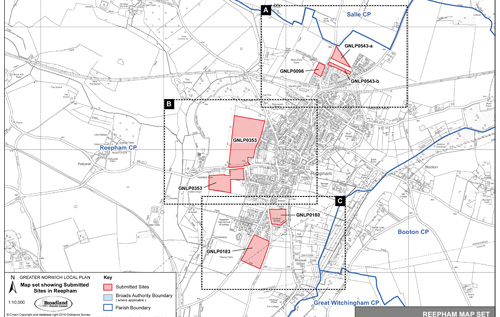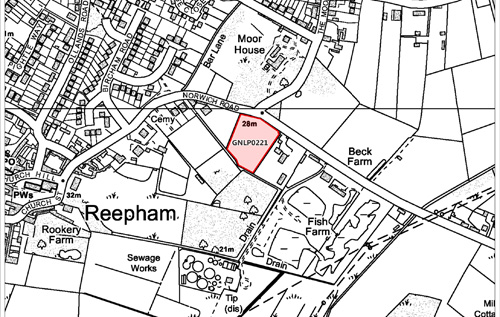More housing sites submitted in latest development plan
Residents of the Reepham district could see further rounds of consultation with the publication of the latest submitted sites for development as part of the Greater Norwich Local Plan (GNLP), which will consider housing and employment needs to 2036.

Above and below: six sites have been submitted in Reepham as part of the Greater Norwich Local Plan
Following a call for sites earlier this year, six sites have been submitted on the outskirts of Reepham, most of which have been considered – and rejected – in previous development plans.
They include an 11.5-hectare site north and south of the B1145 Dereham Road for a residential development of 100-200 houses to include affordable housing, self-build plots, open space, and potential for expansion of the doctor’s surgery and car park.
The other sites in Reepham are land off Wood Dalling Road (adjacent to Collers Way); north of Whitwell Street; east of Whitwell Road; adjacent Wood Dalling Road; and off Norwich Road.
Other nearby submitted sites in the Broadland district include land in Attlebridge, Cawston, Foulsham, Great Witchingham and Weston Longville.
The GNLP builds on the current Joint Core Strategy to 2026 developed by the Greater Norwich Development Partnership (GNDP), which includes Broadland District Council, Norwich City Council and South Norfolk Council, working with Norfolk County Council, and is designed to ensure the area’s housing and jobs needs continue to be met to 2036.
Based on the findings of the Central Norfolk Strategic Housing Market Assessment published in January 2016, it is likely that around 12,000 additional houses will be required in the Greater Norwich area from 2012 to 2036.
This number of houses is over and above those which currently benefit from planning permission or which are set out in existing (or soon-to-be adopted) local plan documents (see “Current allocations” for Reepham below).
The GNDP says this does not mean that all or most submitted sites will be allocated for development: “Experience shows that far more greenfield sites are likely to be submitted than will be needed. Many sites will be inappropriate due to constraints and/or remoteness from services, and other sites simply will not be needed, even if not inappropriate in principle.”
Speaking at November’s Reepham Town Council meeting, District Councillor Graham Everett agreed that it was unlikely that any of the sites in Reepham would be brought forward at this point in time as the rural policy areas already have a sufficient land supply going forward.
“There is currently no requirement for any further development in rural areas such as Reepham as Broadland overall has more than a five-year land supply,” he told Reepham Life. “However, if residents want to support any of these new sites, or if a need arises, I will be happy to take this forward,” said Mr Everett, who has been appointed to Broadland’s Planning Committee.
Growth constraints
It has also been announced that although a “key service centre” Reepham, with a population of 2,709 in 2001, is not considered suitable for further “strategic-scale growth”.
According to a paper presented to a GNDP meeting on 14 November, the town is described as having a good range of services and facilities, including a high school, a doctors’ surgery and a range of shops and employment.
However, Reepham is around 14 miles (22 km) from Norwich and 11 km (7 miles) and 17 km (11 miles) from Aylsham and Dereham respectively, with limited bus services and variable-quality roads.
“Additional development would need to focus on the self-containment of the settlement, although further development in the centre is likely to be limited by Conservation Area/Listed Building restrictions and limited access to strategic employment,” the GNDP was informed.
Further, “there are areas of grade 2 agricultural land to the north-west and south-east of the town and flood risk between Reepham and Booton in the vicinity of the Booton Common Site of Special Scientific Interest (SSSI). Current information indicates that sewerage capacity is significantly limited, constraining any significant scale of growth.”
The GNDP said further work will be needed to establish whether lower levels of non-strategic growth can be accommodated in small towns such as Reepham.
Future needs
Much of the new housing and employment development in Broadland is expected to take place in areas such as Hellesdon, Taverham and Drayton, particularly along the route of the £178.5 million Norwich Northern Distributor Road (NDR), which is planned to open towards the end of 2017. Meanwhile, a key element of the GNLP is to ensure the need for employment land is met, alongside the need for new homes.
The GNDP says development on brownfield sites throughout the three districts will be maximised. However, they admit that in a largely rural area such as Greater Norwich it is inevitable that some new development will have to be on greenfield sites.
The first consultation on the GNLP is scheduled for October-December 2017, with a public examination in June 2020 and possible adoption in December 2020.
Current allocations
Broadland District Council’s current Site Allocations Development Plan Document (DPD) anticipates around 120 houses to be built on land off Broomhill Lane, Reepham, as well as a further 20 houses in a mixed residential/employment brownfield site on land at the former station yard on Station Road, Reepham.
However, to date, neither of these two sites has sought planning permission by developers, who have three years to submit a detailed planning application from the date of adoption of the DPD (May 2016).
At present, there are around 180 dwellings due to be built in Reepham through outstanding planning permissions and current allocations.
Brownfield sites
Meanwhile, new research published by the Campaign to Protect Rural England (CPRE) claims that suitable brownfield sites across England can provide at least 1.1 million new homes. The research, which used the government’s own pilot brownfield register scheme, calculated that suitable brownfield sites can provide between 1.1 and 1.4 million new homes.
CPRE studied the findings of 53 councils that have published their data on suitable sites and found that these areas alone could provide 273,000 homes.
Comparing this new data with the last available data from 2010-2012, CPRE noted an 11% increase in the number of homes that could be provided on suitable sites, with planning permissions for such sites increasing by 21% and the number of suitable sites being identified by 50%.
Applying the same 11% increase to the 2010-2012 figures for the whole country gave a new estimated minimum capacity of 1.1 million homes on suitable brownfield sites, CPRE insisted.
It also noted that the study of the 53 pilot registers produced a figure of 273,000 that was both higher than previous government estimates of countrywide brownfield housing capacity and almost enough for the participating councils to meet their five-year housing targets without releasing any countryside for development.
CPRE chief executive Shaun Spiers said: “We need to build good, affordable homes quickly in the right places. No one is suggesting that we will be able to provide all the homes we need without ever building on a greenfield site. “But the government needs to do much more to reconcile its commitment both to build a million homes and to protect the countryside, including the greenbelt it recently described as ‘sacrosanct’.”
Meanwhile, CPRE Norfolk has said that there is currently no officially designated green belt around Norwich “to help protect our green spaces and open countryside from excessive, inappropriate and unnecessary development. There are currently hundreds of planning applications to build thousands of houses on greenfield sites around the periphery of one of England’s most important historic cities.
“CPRE Norfolk believes that where there is a proven need for new houses, brownfield sites should be considered first, as they are less damaging to the countryside, create less of a carbon footprint, plug into existing infrastructure, are more convenient places to live and help keep the local economy thriving.”

